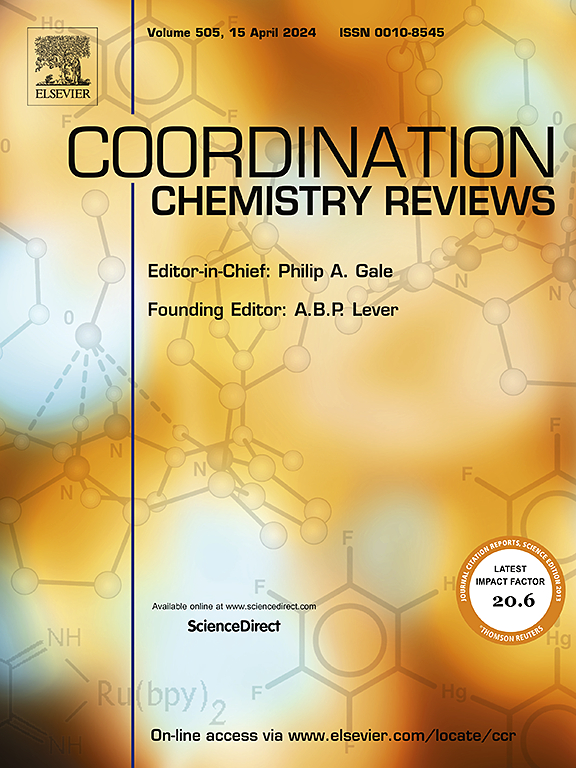小分子光敏剂:为改进皮肤病学的光动力疗法铺平道路
IF 20.3
1区 化学
Q1 CHEMISTRY, INORGANIC & NUCLEAR
引用次数: 0
摘要
皮肤是人体最大和暴露最多的器官,在保护内脏器官和调节代谢过程中起着至关重要的作用。皮肤病如牛皮癣、痤疮和皮肤癌显著影响患者的生活质量,并提出相当大的治疗挑战。传统的治疗方法往往存在局限性,包括副作用、低疗效、侵入性和高成本,这突出了对替代、非侵入性治疗的需求。光动力疗法(PDT)已成为一种有前途的、选择性的、损伤最小的治疗皮肤病的方法。PDT依靠光敏剂,在光激活后,产生活性氧(ROS)来选择性地损伤受影响的细胞。然而,PDT受到溶解度差、光稳定性低和组织靶向性不足等问题的限制。小分子光敏剂的最新进展,包括fda批准的药物和临床试验中的药物,通过提高溶解度、稳定性和靶向能力,解决了这些局限性。纳米技术,特别是纳米载体的集成,通过增强光敏剂的传递和更深的渗透,进一步提高了PDT的效率。本文综述了基于小分子的PDT的最新进展,重点关注光敏剂修饰、它们的光物理性质以及优化溶解度、稳定性和靶向性的策略。本文还讨论了纳米载体在提高给药能力方面的作用以及PDT在临床应用中面临的挑战。本文章由计算机程序翻译,如有差异,请以英文原文为准。
Small molecule photosensitizers: Paving the way for improved photodynamic therapy in dermatology
The skin, the largest and most exposed organ, plays a vital role in protecting internal organs and regulating metabolic processes. Dermatological diseases such as psoriasis, acne, and skin cancer significantly affect patients' quality of life and present considerable therapeutic challenges. Conventional treatments often suffer from limitations, including side effects, low efficacy, invasiveness, and high costs, underscoring the need for alternative, non-invasive therapies. Photodynamic therapy (PDT) has emerged as a promising, selective, and minimally damaging approach for treating skin diseases. PDT relies on photosensitizers that, upon light activation, generate reactive oxygen species (ROS) to selectively damage affected cells. However, PDT is constrained by issues such as poor solubility, low photostability, and inadequate tissue targeting. Recent advances in small molecule photosensitizers, including FDA-approved agents and those in clinical trials, have addressed these limitations by enhancing solubility, stability, and targeting capabilities. The integration of nanotechnology, particularly nanocarriers, further improves PDT efficacy by enhancing delivery and enabling deeper penetration of photosensitizers. This review examines recent developments in small molecule-based PDT, with a focus on photosensitizer modifications, their photophysical properties, and strategies to optimize solubility, stability, and targeting. The role of nanocarriers in enhancing delivery and the challenges in clinical application of PDT are also discussed.
求助全文
通过发布文献求助,成功后即可免费获取论文全文。
去求助
来源期刊

Coordination Chemistry Reviews
化学-无机化学与核化学
CiteScore
34.30
自引率
5.30%
发文量
457
审稿时长
54 days
期刊介绍:
Coordination Chemistry Reviews offers rapid publication of review articles on current and significant topics in coordination chemistry, encompassing organometallic, supramolecular, theoretical, and bioinorganic chemistry. It also covers catalysis, materials chemistry, and metal-organic frameworks from a coordination chemistry perspective. Reviews summarize recent developments or discuss specific techniques, welcoming contributions from both established and emerging researchers.
The journal releases special issues on timely subjects, including those featuring contributions from specific regions or conferences. Occasional full-length book articles are also featured. Additionally, special volumes cover annual reviews of main group chemistry, transition metal group chemistry, and organometallic chemistry. These comprehensive reviews are vital resources for those engaged in coordination chemistry, further establishing Coordination Chemistry Reviews as a hub for insightful surveys in inorganic and physical inorganic chemistry.
 求助内容:
求助内容: 应助结果提醒方式:
应助结果提醒方式:


